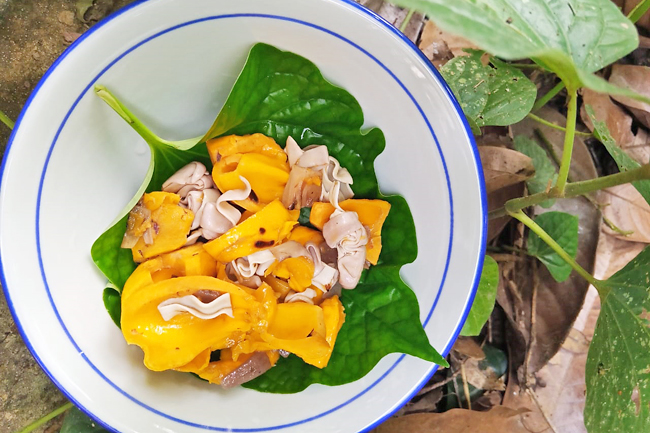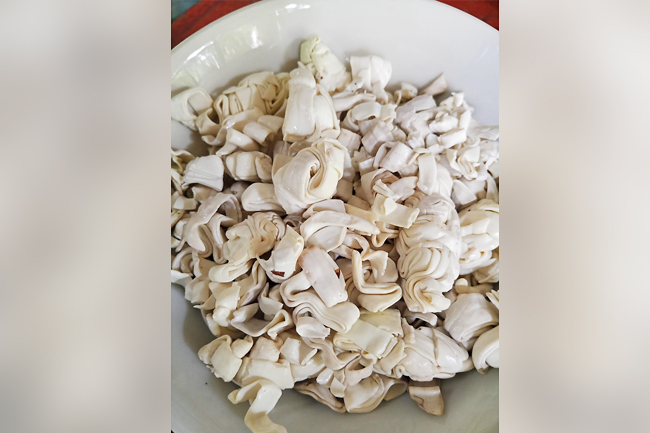Borneo – and by extension, the Sultanate – is a treasure trove of exotic fruits. As this year’s fruit season draws to a close, it has truly been what some of the local ethnic tribes are calling a “grand fruit year”.
Even fruits we’ve never seen before are emerging from the jungles, adding to the rich diversity of Borneo’s natural offerings.
In our previous piece, we explored the maritus or mitus fruit – a larger relative of the Bornean olive, known locally as kembayau.
For some ethnic groups, this fruit is a crucial source of sustenance, while for others, it holds cultural significance, even appearing in traditional games passed down through generations.
In today’s article, we will dive into how the Dusun ethnic group from Kampong Lamunin incorporate this fruit into their traditional cuisine.
As we previously mentioned, the most prized part of the fruit is hidden within its seed – the cotyledon.
We’ll explore three distinct dishes where this unique “Bornean nut” shines, showcasing how ethnic tribes of the past cleverly used this rainforest treasure to enhance their culinary traditions.
MARITUS WITH YOUNG OR UNRIPE DURIAN
To create this unique dish, start by mincing three cloves of garlic and chopping a small red onion. The key ingredient is a young, unripe durian – make sure the flesh is still firm for that perfect texture.
Young durian fruits were traditionally used by ethnic communities as a type of vegetable.
While the flesh of a ripe durian is soft and sweet, the unripe fruit offers a firm texture, making it perfect for use in savoury dishes. For this particular recipe, a young durian pulu is used.





To begin, heat a pan over medium heat and add a little oil. Sauté the minced garlic and chopped onion until they become fragrant and soft.
Next, cut the young durian into chunks and add it to the pan, cooking until the durian becomes tender, stirring occasionally.
At this point, you can add the maritus – either raw or pre-boiled – and mix everything together so the flavours meld. If you’re including shrimp or anchovies, toss them in now and cook until done.
Season with salt and any additional spices you prefer, adjusting the consistency by adding water if needed. Once everything is cooked through and the flavours have come together, serve your dish hot, either as an appetiser or side dish.
MARITUS WITH CASSAVA LEAVES (SAYUR PUCUK UBI)
Begin by shredding and pounding fresh cassava leaves, a staple in many traditional dishes. In a pan, fry three tablespoons of dried shrimp until crispy to bring out their deep umami flavour.
Next, mince two cloves of garlic and chop five shallots – aromatics that form the base of many ethnic dishes, much like we have discussed in earlier sections.
Sauté the garlic, shallots, and crispy dried shrimp together until fragrant. Once the mixture is golden, add the wilted cassava leaves, stirring to coat them in the rich flavours.
Pour in a cup of water to help the ingredients soften and blend. Season with salt and any preferred spices, and don’t forget to add sliced red chilies if you like a bit of heat.
For the final touch, toss in the maritus, either raw or pre-boiled, just as we explored in previous recipes. Let everything simmer until the flavours have fully melded, and serve the dish hot.
It works beautifully as a side dish or even a centrepiece for a traditional meal, bringing together the forest’s bounty and age-old culinary techniques.
KUDAPAN (FRIED MARITUS WITH ANCHOVIES)
Kudapan is a savoury fried snack that brings a delightful crunch to your palate.
Start by frying a few cloves of garlic and a small shallot until they turn golden and crispy. As they cook, add your preferred seasonings to infuse them with flavour.
In a separate pan, fry some anchovies until they are crispy, and in another pan, fry the maritus. It’s important to fry these components separately to avoid burning the delicate aromatics.
Once the garlic and shallot are nearly done, toss in a few curry leaves to add depth of flavour. Combine the fried anchovies and maritus with the aromatics, mixing well. Finish with a touch of sugar and salt to taste.
Traditional recipes may not include anchovies or curry leaves, so their addition represents a modern twist on this classic snack. This fusion approach enhances the dish with additional layers of flavour while honouring its roots.
The maritus fruit, with its abundant seasonal harvest, serves as more than just a culinary delight – it embodies the spirit of sharing and creativity within ethnic communities.
When the maritus trees bear fruit, they do so in great abundance, prompting local communities to explore a variety of recipes to make the most of this bountiful gift.
This ingenuity is rooted in the tradition of sharing, as community members come together to enjoy and extend their harvest.
Whether incorporating the maritus into savoury dishes or creating modern snacks, these recipes reflect a deep-seated cultural practice of ensuring that no part of the bounty goes to waste.
Through this communal effort, the maritus fruit not only nourishes but also connects people, making every meal a celebration of both heritage and togetherness. – Wardi Wasil






